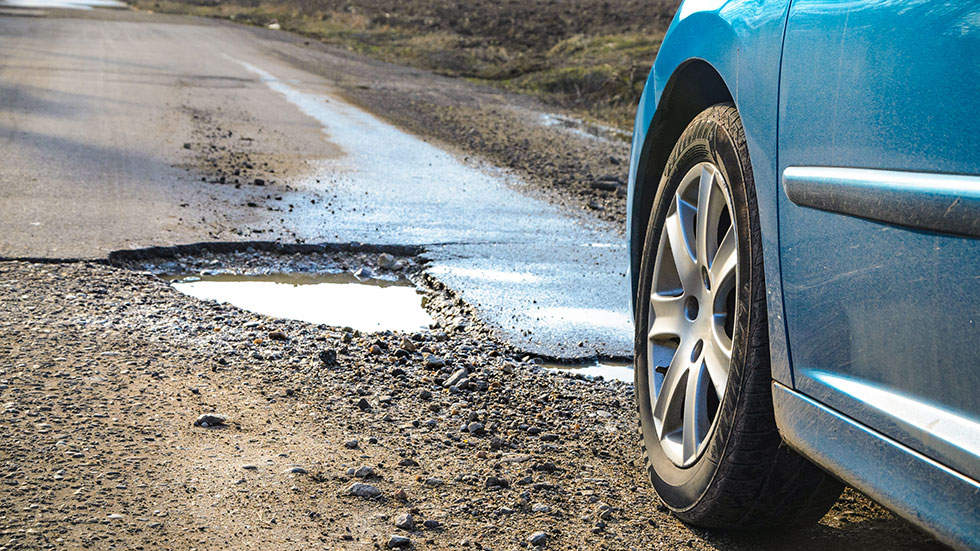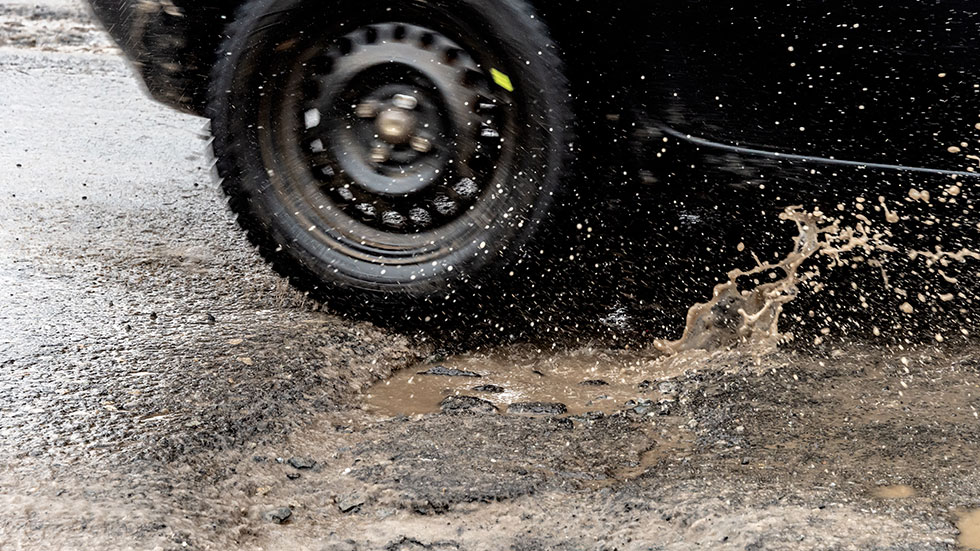The Cause Of Potholes And How To Handle Damage
WHERE TO HAVE YOUR VEHICLE SERVICED


Seasoned drivers will be all too familiar with the sensation of being jarred and gripping the steering wheel tight as their vehicle THUD THUDS over a fresh pothole. Then there are the familiar seconds afterwards where we sit and wonder if anything was damaged. We listen closely to the sounds the vehicle makes and feel cautiously, moving our steering wheel to see if anything feels out of place, like a damaged tire or wheel.
Potholes are an unfortunate reality every driver eventually encounters. In this article, we’ll take a closer look at what causes potholes, how to spot them, and steps you can take to avoid damaging your vehicle driving over them.
WHAT CAUSES POTHOLES?
Potholes are the result of wet soil underneath asphalt creating structural weakness. When moisture gets into the soil under road surfaces, as vehicles continually cross these patches of weakened asphalt, they create divots in the pavement. These divots eventually crack and break loose. Pieces of asphalt are then gradually removed by the crossing traffic, resulting in a hole in the pavement.
In parts of the country that regularly experience temperatures that freeze and thaw repeatedly, water that has worked its way into cracks in asphalt expands as it freezes, deepening the cracks and pushing loose asphalt aside. As the freezing/thawing cycle continues over time, cracks become larger and vehicles crossing will eventually create a pothole.

ARE CERTAIN VEHICLES MORE LIKELY TO BE DAMAGED BY POTHOLES?
The lower your vehicle rides to the ground, the more susceptible it will be to pothole damage. A lower ride means lower clearance on the undercarriage of your car. If you drive a lowered vehicle or performance sports car, extra attention needs to be devoted to avoiding potholes to avoid damage. Not only can your wheel assembly or tires be damaged, but components like your exhaust can be crushed or scratched, leading to rust formation and possibly performance issues down the road.
Similarly, vehicles with customized wheels, low-profile tires, or other cosmetic and performance enhancements can be more prone to damage when hitting a pothole. Although no one ever wants to drive over a pothole, if you’ve invested a lot into the performance or cosmetics of your vehicle, keep in mind that hitting a pothole may wind up being very expensive for you.

ARE CERTAIN TIRES MORE LIKELY TO BE DAMAGED BY POTHOLES?
While low profile tires (shorter sidewalls) give drivers enhanced handling and performance, they significantly increase the chances of damage when striking a pothole. With their shortened tire walls and the fact that their treads sit closer to the wheel, there is simply less tire and air to protect your wheel, suspension, ball joints, and more from the impact of a pothole.
High profile tires (taller sidewalls) like those found on pickup trucks or some SUV’s provide the most protection due in part to their rugged construction but also because higher sidewalls and rugged treads give them extra padding to protect your wheel assembly and tires from damage.

WHAT IS THE MOST COMMON POTHOLE DAMAGE TO VEHICLES?
While tires certainly bear the brunt of many pothole strikes, it’s important to remember that your vehicle is comprised of thousands of delicate parts, many of which reside in the wheel assembly and are critical to your vehicle working properly.
Striking a pothole can damage, bend, or break any of the following components on your car or truck.
- Tires/Wheels – A pothole strike can easily tear a hole in your tire, bursting it or damaging the sidewall to a point where it will need to be replaced. Flat tires will do little to protect your wheels, which can also be bent by severe pothole strikes.
- Control Arm – A suspension component that is the direct connection point between the front wheels and your vehicle’s frame. They are what allows you to steer while also allowing your wheels to move up and down with the road’s surface. If your steering feels off after a pothole strike, you may have bent a control arm.
- Tie Rod – Another steering component, tie rods work in conjunction with your ball joints, allowing you to steer smoothly and keep the front end of your vehicle aligned. If steering feels difficult or strange after striking a pothole, your tie rods may be damaged.
- Shock/Strut – Shocks and struts help stabilize your vehicle while in motion, giving you better control when you accelerate, turn, brake, or encounter bumpy road surfaces. After striking a pothole, if your vehicle feels like it tips to one side in turns or it feels wobbly, you may have damaged shocks or struts.
WHAT’S THE BEST WAY TO AVOID POTHOLE DAMAGE?
Although fresh potholes can lurk down any stretch of road, fortunately there are some simple steps drivers can take to avoid them and prevent expensive damage to their vehicles.
- Check your tires frequently, especially during the late winter and early spring months when fresh potholes are most common. Simply ensuring your tires are properly inflated can save you from damaged tires, wheels and more. Be sure to examine for significant wear or damage to tires as well, because damaged tires, even when properly inflated, can be a hazard.
- Check your suspension. You may not be able to look at or feel these components easily, but paying attention to how your vehicle drives, staying alert for anything that feels off like tipping, wobbling, or a harsh ride, could alert you to suspension problems. A properly working suspension will help absorb any pothole impacts, protecting your other components.
- Pay attention and look ahead. Vigilant drivers are usually the ones who are best at avoiding hitting potholes altogether. Get in the habit of scanning the road ahead of you, keeping an eye out for fresh potholes or puddles that may be concealing them. After all, the best way to avoid pothole damage is to not hit them in the first place! Always be aware of your surroundings, ensuring there are no other pedestrians, vehicles, or bicycles in the way as you swerve to miss a pothole.
- Slow down. Sometimes you can’t avoid a pothole. In these instances, it’s always best to drive over them as slowly as possible, giving you the best chance of escaping without significant damage.
Potholes are an ever-present nuisance on surface streets and roads, and they can literally pop up overnight. By keeping a few of the things we’ve discussed top of mind every time you get behind the wheel, you can avoid most of them and prevent expensive repairs to your vehicle.
